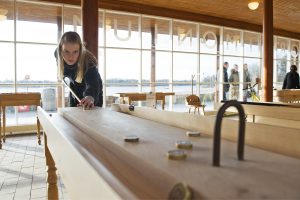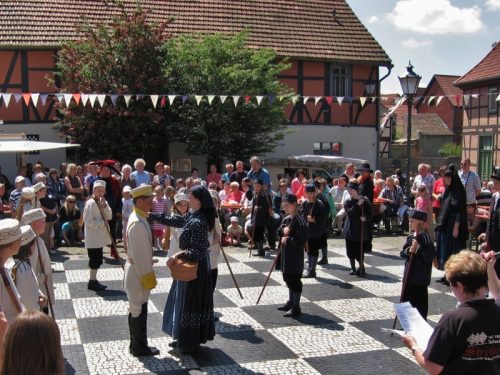Recognizing Games as Cultural Heritage
09 Jan
Posted by David Miller as Card Games, Classic Board Games
In 2014, the United Nations Educational, Scientific and Cultural Organization (UNESCO) placed on its Representative List of the Intangible Cultural Heritage of Humanity the game of Mongolian Knuckle-Bone Shooting. The game is played by flicking sum (tiles made from deer horn) along khashlaga (wood guides) to knock down khasaa (dice targets made of sheep bones). The khasaa are stacked in a stage-like backdrop called aravch. Another common tool for the game is the havchaakhai, a crossbow-like device that elderly players can use instead of flicking. Instead of free-form cheers and jeers, a regular system of songs and chants exists, with players from all teams, even competitors, joining-in for specific tunes based on a shooter’s performance.
To help maintain cultural heritage in the Asia-Pacific region, UNESCO in Bangkok has collected a catalog of 90 traditional children’s games with advice on how to use them in an educational setting.
In Djibouti, a UNESCO project, “Safeguarding Traditional Games of the Afar and the Somali People in the Horn of Africa“, worked with local authorities in 2007-2008 to survey the games of regional nomadic societies. Kits were produced for three traditional board games—Bub, Riyo ka dhalis, and Shax—and distributed in three languages to all high schools and ministries in the country. A national tournament series was even held, with over 300 hundred participants.
More recently, UNESCO has begun working with Chinese IT company Tencent to create a digital library of traditional games.
 UNESCO’s Intangible Cultural Heritage program has additionally recognized the Sportimonium, a museum in Belgium, for its cultivation of “ludodiversity”. Much of the institution is focused on the preservation and study of sports artifacts but it also pays significant attention to traditional tabletop and garden games, which are on display, as well as available for borrowing.
UNESCO’s Intangible Cultural Heritage program has additionally recognized the Sportimonium, a museum in Belgium, for its cultivation of “ludodiversity”. Much of the institution is focused on the preservation and study of sports artifacts but it also pays significant attention to traditional tabletop and garden games, which are on display, as well as available for borrowing.
The German Commission for UNESCO maintains its own Inventory of Intangible Cultural Heritage, on which it lists the Chess traditions of Ströbeck village and the playing of Skat. Chess in Ströbeck goes back to the year 1011. The village for much of that time played its own variant with 96 squares called Courier Chess, has mandated Chess education in primary schools since 1823, has held games of living Chess since 1688, and requires grooms to play Chess against the mayor in order to win their bride. Skat is a trick-taking card game for three players (or four with one sitting out each round) originating from 1813 and now popular across Germany.

- Comments Off on Recognizing Games as Cultural Heritage
Trending
- Massdrop.com
- Oh the Irony—Illuminati Card Game Continues to Inspire Conspiracy Theorists
- Home
- Footprints, an Educational Ecology Game
- USPS Adds Board Game Flat Rate Box
- Baila, the Estonian Drinking Card Game
- Crystal Caste Wins Dice Patent Suit Against Hasbro
- Mirror Game, Red and Blue
- Hasbro and Mattel Merger?
- Are Board Games Dangerous?
Archives
Most Popular Articles
- Oh the Irony—Illuminati Card Game Continues to Inspire Conspiracy Theorists
- The 20 Most Valuable Vintage Board Games
- The Truth About Dominoes On Sunday in Alabama
- Sequence Game, and Variants
- USPS Adds Board Game Flat Rate Box
- Baila, the Estonian Drinking Card Game
- The 13 Most Popular Dice Games
- Are Board Games Dangerous?
- Guess Who? The Naked Version
- What Happened to the Jewel Royale Chess Set?
Recent Posts
- Toy Fair 2019—Breaking Games
- Talisman Kingdom Hearts Edition
- Toy Fair 2019—Winning Moves
- Toy Fair 2019—Games Workshop
- Toy Fair 2019—Star Wars Lightsaber Academy
- Toy Fair 2019—Stranger Things Games
- Toy Fair 2019—HABA
- Licensing Roundup
- Game Bandit
- 2018 A Difficult Year For Hasbro But Not For D&D Or MtG
Recent Comments
- on Toy Fair 2019—Winning Moves
- on Game Bandit
- on Second Look—Dungeons & Dragons Waterdeep Dragon Heist
- on Crowdfunding Highlights
- on Beyblade SlingShock
- on Game Bandit
- on Game Bandit
- on Watch This Game!, the Board Game Review Board Game
- on Second Look—Vampire: The Masquerade 5th Edition
- on Palladium Books Loses Robotech IP License, Cancels Five-Year-Overdue Robotech RPG Tactics Kickstarter




